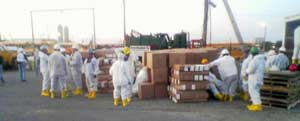Union takes charge after cement explosion
By
Gerry Scoppettuolo
Boston
Published Oct 15, 2006 11:34 PM
On
Sept. 28 an industrial silo exploded near the Charlestown yard where Boston
school buses are kept. It spewed out a reported 3,000 pounds of toxic slag dust,
which settled on the school bus drivers and their
vehicles.
|
Hazmat workers
clean area near
parked school
buses.
WW photo: Steve Gillis
|
The slag, a component of
cement, exposed the drivers to crystalline silica and other harmful metals and
chemicals, according to the company’s own report. Some 147 drivers were
brought to area hospitals by emergency crews. The harm caused by the disaster is
still being assessed.
Shaking off the
potentially harmful effects to themselves, and without waiting for the bus
company, First Student, to deal with the situation, the school bus drivers and
their union sprang into action. The largely Haitian, Cape Verdean, Latin@ and
African American work force and their union, United Steel Workers Local 8751,
have long been known as a first line of defense for school desegregation and for
the over 35,000 students who ride to school in
Boston.
While the company seemed
paralyzed, the drivers showed they could also deal with other areas of the
people’s transportation business.
Workers set up command
center
With military-like
discipline, the drivers’ union evacuated the bus yard and set up a command
center in the cafeteria of nearby Charleston High School. There, while still
breathing in harmful slag particles, they organized their own food and water
needs and began to dispatch drivers to schools and other bus yards so the
children could get home
safely.
Meanwhile, union officers
demanded that the bus company clean the drivers’ cars first. This process,
organized by the union in a spirit of solidarity, took until 1:30 a.m. The
drivers were required to be at work the next morning at 5:30 a.m. The School
Department had refused union advice to cancel school so children would not be
left stranded.
Union Vice President
Steve Gillis arrived at the bus yard 10 minutes after the explosion. “For
the safety of the drivers, monitors, mechanics and school children,” he
told Workers World, “the union stopped the buses from going out with the
unknown dust on them, which would otherwise have happened. The drivers rejected
buses going out with dust still on them, and the union had dispatchers recall
contaminated buses the company had already sent
out.”
The union’s chief
steward made a list of all exposed workers. Many bus monitors, who are mostly
Haitian women, were among those brought to the hospital. The company made no
list of its own and, according to union officers, never gave an order for the
workers to evacuate the bus yard.
Greedy companies and do-nothing
authorities
While the cement
disaster was unprecedented, the unfeeling response of city authorities was all
too predictable. Without benefit of scientific sampling of the contaminated
area, the Boston Public Health Commission issued a statement claiming that the
dust was mostly confined to the Lafarge Cement Co. yard. Charged with protecting
the health of its residents, the city agency made no mention of the workers who
might have been exposed.
A hazardous
materials clean-up company crew boss had told union officials it was nothing but
“nuisance dust that we’ll have out of here in a few hours.” In
fact, it took six days of round-the-clock work by mostly Latin@ hazmat workers,
organized by the Laborers’ Union, to clean the
area.
An Occupational Safety and Health
Administration inspector took samples of the slag, promising results in
“up to six weeks,” while rejecting an offer from the United Steel
Workers’ Health and Safety Department to share a portion of the sample so
it could conduct its own sampling and get results in 24
hours.
The Boston cement dust disaster
is a perfect example of corporate greed in league with do-nothing government
regulatory agencies. Lafarge North America, which was responsible for the
accident, is a multi-billion-dollar international corporation that extracts
profits from workers in literally dozens of countries across the
globe.
First Student acquired the
contract to run Boston school buses three years ago when it underbid the
competition by $10 million. It then moved the Charlestown drivers from a
building in Sullivan Square to a trailer on the industrial
waterfront.
OSHA was created in 1970 as
a concession to organized workers’ demands for health and safety
protection. Since that time it has become a transparent servant of corporate
capitalist interests, allowing violators lenient terms to “abate,”
or remedy, the hazardous work places they
control.
Only complete control of
working conditions by the workers, through a system based on health and safety
rather than profits, can possibly avert future disasters like this one. On Sept.
28, the Boston school bus drivers’ union, made up of 800 mostly immigrant
workers, demonstrated that—without bosses, politicians or the need to make
profits—the workers and schoolchildren could organize themselves to deal
with a real health emergency.
Articles copyright 1995-2012 Workers World.
Verbatim copying and distribution of this entire article is permitted in any medium without royalty provided this notice is preserved.
Workers World, 55 W. 17 St., NY, NY 10011
Email:
[email protected]
Subscribe
[email protected]
Support independent news
DONATE


